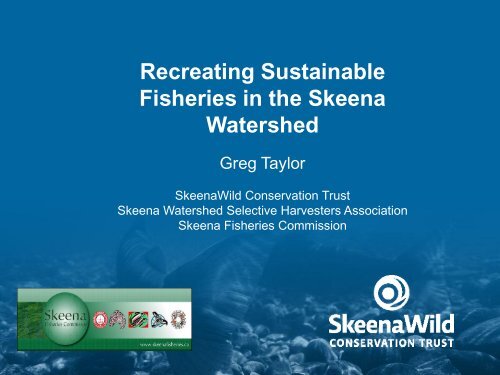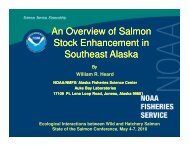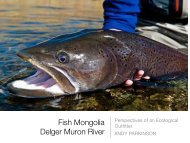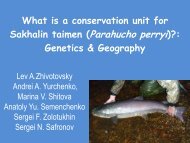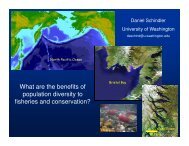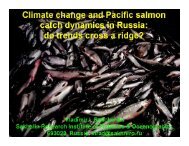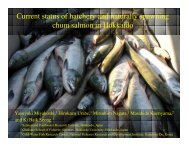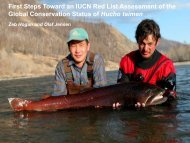Recreating Sustainable Fisheries in the Skeena Watershed
Recreating Sustainable Fisheries in the Skeena Watershed
Recreating Sustainable Fisheries in the Skeena Watershed
You also want an ePaper? Increase the reach of your titles
YUMPU automatically turns print PDFs into web optimized ePapers that Google loves.
<strong>Recreat<strong>in</strong>g</strong> <strong>Susta<strong>in</strong>able</strong><br />
<strong>Fisheries</strong> <strong>in</strong> <strong>the</strong> <strong>Skeena</strong><br />
<strong>Watershed</strong><br />
Greg Taylor<br />
<strong>Skeena</strong>Wild Conservation Trust<br />
<strong>Skeena</strong> <strong>Watershed</strong> Selective Harvesters Association<br />
<strong>Skeena</strong> <strong>Fisheries</strong> Commission
<strong>Skeena</strong> Sockeye<br />
Conservation Units<br />
Map courtesy of <strong>Skeena</strong> <strong>Fisheries</strong><br />
Commission<br />
1. Johnston<br />
2. Alastair<br />
3. Lakelse<br />
4. Kisumkalum<br />
5. McDonnell<br />
6. Dennis<br />
7. Aldrich<br />
8. Kitwanga<br />
9. Stephens<br />
10. Club<br />
11. Swan<br />
12. Sic<strong>in</strong>t<strong>in</strong>e<br />
13. Slamgeesh<br />
14. Damshilgwit<br />
15. Motase<br />
16. Bear<br />
17. Azuklotz<br />
18. Asitka<br />
19. Sustut<br />
20. Spawn<strong>in</strong>g<br />
21. Johanson<br />
22. Kluayaz<br />
23. Kluatantan<br />
24. Morice<br />
25. Atna<br />
26. Bulkley<br />
27. Maxan<br />
28. Bab<strong>in</strong>e<br />
29. Morrison
Snapshot of Current Status<br />
of <strong>Skeena</strong> Sockeye Stocks<br />
Serious<br />
Concern, 5<br />
Current Status of <strong>Skeena</strong> <strong>Watershed</strong>'s<br />
30 Sockeye (Lake Type) Conservation Units<br />
(SWCT, 2008)<br />
Insufficient<br />
Escapement<br />
Data, 17<br />
(Most are assumed to<br />
be overfished to some<br />
degree)<br />
Concern, 6<br />
No Concern, 2<br />
The X-axis represents <strong>the</strong> exploitation rate<br />
that <strong>the</strong> Independent Science Report stated<br />
would allow for <strong>the</strong> preservation (not<br />
rebuild<strong>in</strong>g to allow for FN access, etc.) of<br />
depressed <strong>Skeena</strong> sockeye stocks. This<br />
graph shows that stocks such as Kitwanga<br />
have been exploited – on average - <strong>in</strong> excess<br />
of 135% of <strong>the</strong> recommended m<strong>in</strong>imum rate<br />
s<strong>in</strong>ce 1982.<br />
P<br />
e<br />
r<br />
c<br />
e<br />
n<br />
t<br />
a<br />
g<br />
e<br />
D<br />
i<br />
f<br />
f<br />
e<br />
r<br />
e<br />
n<br />
c<br />
e<br />
40.0%<br />
35.0%<br />
30.0%<br />
25.0%<br />
20.0%<br />
15.0%<br />
10.0%<br />
5.0%<br />
0.0%<br />
Percentage Difference from ISRP Target Aggregate<br />
Exploitation Rate<br />
(ISRP Recommendation is 30-40%: chart uses 35%)<br />
Wild Bab<strong>in</strong>e Coastal CU's Below Kasiks Kitsum- Kalum<br />
Mid-<strong>Skeena</strong> Below Fiddler Kitwanga Lake Bulkley/ Morice Hazelton to Low. bab<strong>in</strong>e<br />
Morrison (Bab<strong>in</strong>e) Upper Sk Bel Sustut Upper Sk. Bear Upper Sk & Sustut
First Management Era: 3,000 BC to 1877<br />
Pictures courtesy of Allen Gottesfeld
• <strong>Skeena</strong> First Nations harvested salmon at<br />
relatively high harvest rates for at least 5,000<br />
years.<br />
• Archeologists and traditional FN history <strong>in</strong>dicate<br />
that First Nation’s population was limited by salmon<br />
abundance. FN’s would have tended to fish to <strong>the</strong><br />
susta<strong>in</strong>able limits of salmon populations <strong>in</strong> <strong>the</strong><br />
areas where <strong>the</strong>y lived.<br />
• This means that at a time when a small village<br />
called Rome was be<strong>in</strong>g founded <strong>the</strong>re was a<br />
susta<strong>in</strong>able fisheries management strategy <strong>in</strong><br />
place <strong>in</strong> <strong>the</strong> <strong>Skeena</strong>.
Robust design and construction would have prevented fish passage<br />
unless <strong>the</strong>re was a management process that allowed for<br />
escapements<br />
Pictures courtesy of Ken Rabnett and Allen Gottesfeld
Bab<strong>in</strong>e Barricades were of <strong>the</strong> most “formidable and impos<strong>in</strong>g<br />
appearance… constructed of an immense quantity of materials, and on<br />
scientific pr<strong>in</strong>ciple… which not a s<strong>in</strong>gle fish could get through.” People<br />
were catch<strong>in</strong>g and process<strong>in</strong>g some “three quarter of a million fish”<br />
Hans Helgerson, Fishery officer 1906<br />
(from Copes. 1995) Picture courtesy of Bill Spenst and <strong>the</strong> Lake Bab<strong>in</strong>e Nation
Relative Time Frames <strong>the</strong> two Management Strategies have been <strong>in</strong><br />
existence and how long – <strong>in</strong> relative terms – it took modern management<br />
to replace a susta<strong>in</strong>able fishery which preserved biodiversity to one that<br />
has placed biodiversity at risk.
<strong>Fisheries</strong> prior to Enhancement: 1873 - 1970
Early Modern Management:<br />
1883 - 1969
Modern Era Sockeye Management:<br />
Attempt<strong>in</strong>g to manage a trade-off between ma<strong>in</strong>ta<strong>in</strong><strong>in</strong>g economic benefits<br />
from a mixed stock fishery and protect<strong>in</strong>g biodiversity
Although Exploitation Rates from 1982 – 2008 appear relatively<br />
constant; <strong>the</strong>y disguise <strong>the</strong> trade-offs DFO has made between<br />
biodiversity and mar<strong>in</strong>e harvests. This graph illustrates management<br />
response to <strong>in</strong>creas<strong>in</strong>g aggregate abundance. Mixed stock harvests are<br />
allowed to <strong>in</strong>crease even though it is understood that such <strong>in</strong>creases<br />
will likely compromise biodiversity
Harvest rates<br />
Harvest rates<br />
Managers have attempted to move mixed stock harvest impacts <strong>in</strong> a<br />
failed effort to ma<strong>in</strong>ta<strong>in</strong> commercial efforts and protect biodiversity<br />
0.0800<br />
0.0700<br />
0.0600<br />
0.0500<br />
0.0400<br />
0.0300<br />
1980 – 1991 Weekly Harvest Rates<br />
Plotted aga<strong>in</strong>st <strong>the</strong> run tim<strong>in</strong>g of<br />
selected stocks of concern<br />
Weekly Harvest Rates for 1980 - 1991 Plotted Aga<strong>in</strong>st <strong>the</strong><br />
Estimated Run Tim<strong>in</strong>g of Morice Sockeye, Kitwanga Sockeye,<br />
Early Timed Steelhead and Coho<br />
1980 - 1991 Harvest Rates<br />
Early Steelhead<br />
Coho<br />
kitwanga Sockeye<br />
Morice/Nanika Sockeye<br />
Reduc<strong>in</strong>g harvest rates <strong>in</strong> August from<br />
1992 – 2002 to protect coho and<br />
steelhead led to a decision to <strong>in</strong>crease<br />
weekly harvest rates <strong>in</strong> July <strong>in</strong> an<br />
attempt to ma<strong>in</strong>ta<strong>in</strong> mixed stock<br />
harvests<br />
0.0800<br />
0.0700<br />
0.0600<br />
0.0500<br />
0.0400<br />
0.0300<br />
Weekly Harvest Rates for <strong>the</strong> 1992 - 2002 Plotted Aga<strong>in</strong>st <strong>the</strong><br />
Estimated Run Tim<strong>in</strong>g of Morice Sockeye, Kitwanga Sockeye,<br />
Early Timed Steelhead and Coho<br />
Early Steelhead<br />
Coho<br />
kitwanga Sockeye<br />
Average Weekly Harvest<br />
Rates 1992 - 2002<br />
Morice/Nanika<br />
0.0200<br />
0.0200<br />
0.0100<br />
0.0100<br />
0.0000<br />
0.0000
Harvest rates<br />
Harvest rates<br />
This resulted <strong>in</strong> <strong>in</strong>creased impacts on Nanika sockeye – a critical food source<br />
for <strong>the</strong> Wet’suwet’en people. Managers responded by curtail<strong>in</strong>g weekly harvest<br />
rates <strong>in</strong> <strong>the</strong> early period and ma<strong>in</strong>ta<strong>in</strong><strong>in</strong>g <strong>the</strong> August restrictions. But <strong>in</strong> an effort<br />
to ma<strong>in</strong>ta<strong>in</strong> mixed stock harvests significantly <strong>in</strong>creased weekly harvest rates <strong>in</strong><br />
<strong>the</strong> middle of <strong>the</strong> season – right on top of o<strong>the</strong>r less productive sockeye stocks.<br />
0.0800<br />
0.0700<br />
0.0600<br />
0.0500<br />
0.0400<br />
Weekly Harvest Rates for 2008 Plotted Aga<strong>in</strong>st <strong>the</strong> Estimated<br />
Run Tim<strong>in</strong>g of Morice Sockeye, Kitwanga Sockeye, Early<br />
Timed Steelhead and Coho<br />
0.0800<br />
0.0700<br />
0.0600<br />
0.0500<br />
0.0400<br />
Weekly Harvest Rates for 2008 Plotted Aga<strong>in</strong>st <strong>the</strong> Estimated<br />
Run Tim<strong>in</strong>g of Morice Sockeye, Kitwanga Sockeye, Early<br />
Timed Steelhead and Coho<br />
Early Steelhead<br />
Coho<br />
Early Steelhead<br />
Coho<br />
kitwanga Sockeye<br />
kitwanga Sockeye<br />
2008 Harvest rates<br />
2008 Harvest rates<br />
Morice/Nanika<br />
Morice/Nanika<br />
0.0300<br />
0.0300<br />
0.0200<br />
0.0200<br />
0.0100<br />
0.0100<br />
0.0000<br />
0.0000
There is ano<strong>the</strong>r way:<br />
Look<strong>in</strong>g back to move Forward
ESSR and Economic Opportunity Harvests totaled almost 3.4 million<br />
sockeye and 260,000 p<strong>in</strong>k salmon between1992 and 2008. The<br />
problem is <strong>the</strong> <strong>in</strong>consistency of supply as DFO typically only allows<br />
ESSR fisheries when sockeye returns well exceed <strong>the</strong> average (blue<br />
arrow)
Location of<br />
Selective<br />
<strong>Fisheries</strong>
2008 Economic Opportunity and ESSR <strong>Fisheries</strong>
Name of Total Median Income Employment<br />
Community Population (<strong>in</strong>cl. transfers) Rate<br />
Gitwangak 465 $11,392 33%<br />
Gitsegukla 721 $7,030 24%<br />
Gitanmaax 723 $13,579 34%<br />
Kispiox 617 $11,104 31%<br />
Moricetown 592 $14,400 45%<br />
Lake Bab<strong>in</strong>e Nation 802 $10,134 32%<br />
Average $11,273 33%<br />
BC Average $31,598 62%<br />
Community economic profiles. Selective <strong>Fisheries</strong> are important for<br />
struggl<strong>in</strong>g First Nations communities.
Distribution of 2008 Selective Fishery Catch
Total revenues for First Nations communities from <strong>the</strong> 2008 selective<br />
fishery totaled almost $1.2 million<br />
$450,000<br />
Mid-River Economic<br />
Opportunity Fishery,<br />
$423,921<br />
$400,000<br />
$350,000<br />
$300,000<br />
Bab<strong>in</strong>e Fence ESSR<br />
Fishery, $307,480<br />
$250,000<br />
$200,000<br />
Gisgagaas Canyon<br />
ESSR Fishery,<br />
$192,723<br />
$150,000<br />
$100,000<br />
P<strong>in</strong>kut Creek ESSR<br />
Fishery, $109,921<br />
Fulton River ESSR<br />
Fishery, $148,488<br />
$50,000<br />
$0<br />
Mid-River Economic<br />
Opportunity Fishery<br />
Gisgagaas Canyon<br />
ESSR Fishery<br />
Bab<strong>in</strong>e Fence ESSR<br />
Fishery<br />
P<strong>in</strong>kut Creek ESSR<br />
Fishery<br />
Fulton River ESSR<br />
Fishery
The “New” <strong>Skeena</strong> Commercial Fishery<br />
Reconnects with <strong>the</strong> Past<br />
• Conservation, biodiversity and ecological <strong>in</strong>tegrity is<br />
paramount <strong>in</strong> all management.<br />
• Peer reviewed science and traditional ecological knowledge<br />
are <strong>in</strong>corporated <strong>in</strong> technical discussions<br />
• Traditional Law <strong>in</strong>fluences fisheries management decisions
Mid-River Selective Beach Se<strong>in</strong>e Fishery<br />
Strengths<br />
1. Excellent quality of fish<br />
2. Ability to harvest allocation<br />
3. Consistent access<br />
4. Very Species Selective<br />
5. Relatively easy logistics<br />
Challenges<br />
1. Mixed stock fishery<br />
2. Access tied to commercial access. As<br />
commercial access decl<strong>in</strong>es so does<br />
Mid-River selective fisheries access.<br />
3. Less harvest opportunities upstream of<br />
Kitwanga River
Gisgagaas Canyon Selective Dip-Net Fishery<br />
Strengths<br />
1. Good quality fish<br />
2. Stock Selective<br />
3. Slow Pace of fishery enhances<br />
fish quality<br />
4. Bleed<strong>in</strong>g program<br />
Challenges<br />
1. Need to improve catch rates to<br />
access entire allocation<br />
2. Dependent on ESSR Allocation<br />
3. Labour <strong>in</strong>tensive transport up<br />
Canyon to ice and trucks<br />
4. Better fish release methods<br />
required <strong>in</strong> some sites<br />
5. Difficult access to fishery
Bab<strong>in</strong>e Fence Dip-Net Fishery<br />
Strengths<br />
1. Good fish quality<br />
2. Reasonable roe maturity<br />
3. Very stock selective<br />
4. High rates of Harvest<br />
5. Good <strong>in</strong>frastructure<br />
Challenges<br />
1. Long access road to fishery<br />
2. Dependent on ESSR Allocation<br />
3. Grizzly bears!
Bab<strong>in</strong>e Lake <strong>Fisheries</strong><br />
Strengths<br />
1. Flesh quality acceptable for market<br />
but can decl<strong>in</strong>e late <strong>in</strong> run<br />
2. Excellent roe maturity and quality<br />
3. High harvest rates<br />
4. Very stock selective<br />
Challenges<br />
1. Dependent on ESSR Allocation
Moricetown P<strong>in</strong>k Fishery<br />
Strengths<br />
1. Excellent direct access to market<br />
2. Located at major tourist attraction<br />
3. Good products<br />
4. High prices for p<strong>in</strong>ks. Relies on good<br />
prices <strong>in</strong>stead of high volumes<br />
5. Excellent roe maturity and quality<br />
6. Reasonable harvest rates when<br />
p<strong>in</strong>ks available<br />
7. Long term successful fishery<br />
8. Very species and stock selective<br />
Challenges<br />
1. Inconsistent access<br />
2. Dependent on ESSR decisions<br />
3. Can not make long term bus<strong>in</strong>ess<br />
decisions
The <strong>Skeena</strong> <strong>Watershed</strong>’s First Nations have come toge<strong>the</strong>r to collectively work<br />
on <strong>the</strong> challenges fac<strong>in</strong>g <strong>the</strong>ir fisheries. They have formed <strong>the</strong> <strong>Skeena</strong><br />
<strong>Watershed</strong> Selective Harvester’s Association (SWSHA). The SWSHA’s<br />
mandate is to:<br />
1. Improve SWSHA’s access to sockeye. Each selective fishery must<br />
have an annual def<strong>in</strong>ed share of <strong>the</strong> Canadian commercial surplus<br />
of <strong>Skeena</strong> sockeye. This will allow SWSHA members to grow <strong>the</strong>ir<br />
bus<strong>in</strong>esses while <strong>in</strong>creas<strong>in</strong>g biodiversity <strong>in</strong> <strong>the</strong> <strong>Watershed</strong><br />
2. Certify all sockeye products as selectively harvested <strong>in</strong> “fair-trade”<br />
fisheries under <strong>the</strong> <strong>Skeena</strong>Wild Certification mark.<br />
3. Develop additional value added opportunities ei<strong>the</strong>r through<br />
market<strong>in</strong>g or product development<br />
4. Identify opportunities where <strong>the</strong> SWSHA might <strong>in</strong>vest <strong>in</strong> ice<br />
mach<strong>in</strong>es, totes, <strong>in</strong>frastructure or process<strong>in</strong>g <strong>in</strong> order to return a<br />
greater share of <strong>the</strong> market value to local communities.
Thank you to <strong>the</strong> follow<strong>in</strong>g for <strong>the</strong> pictures and maps <strong>in</strong> <strong>the</strong> presentation:<br />
Allen Gottesfeld<br />
Ken Rabnett<br />
<strong>Skeena</strong> <strong>Fisheries</strong> Commission<br />
Ecotrust<br />
Bill Spenst<br />
Walter Joseph<br />
Taylor Bachrach<br />
Greg Knox<br />
And special thanks to <strong>the</strong> First Nations of <strong>the</strong> <strong>Skeena</strong> <strong>Fisheries</strong> Commission for<br />
<strong>the</strong>ir efforts over <strong>the</strong> past twenty years. Without it <strong>the</strong>re would not be an <strong>in</strong>land<br />
selective fishery today.


